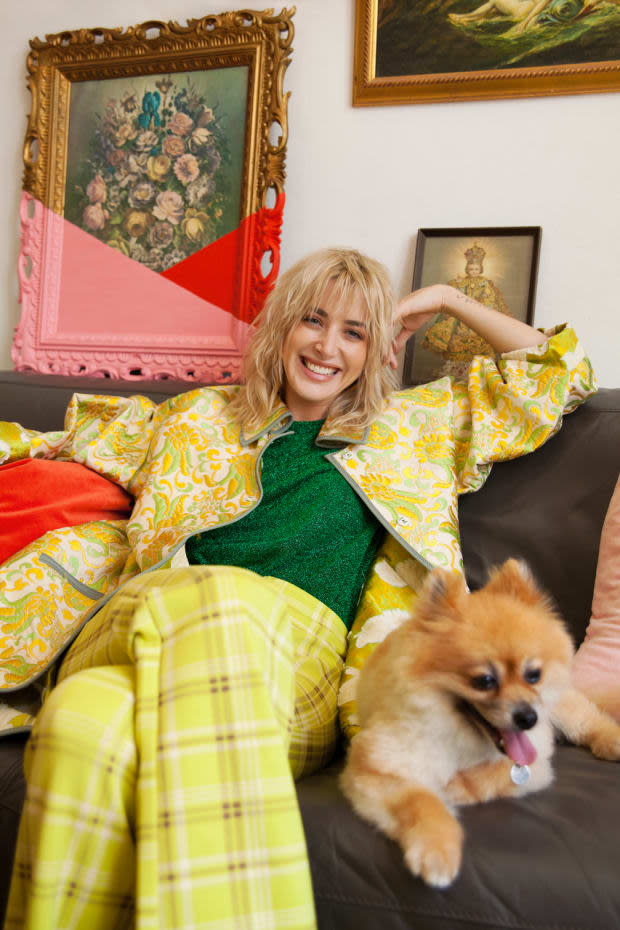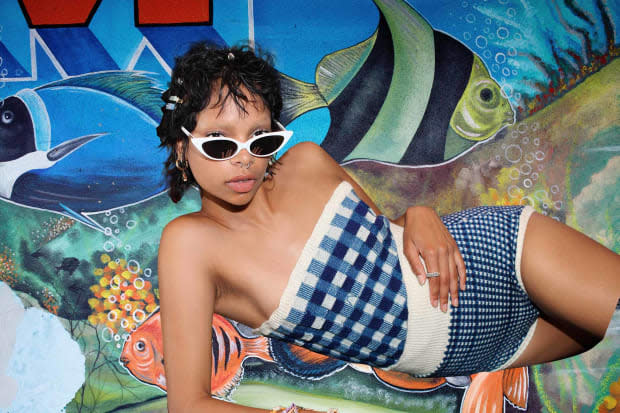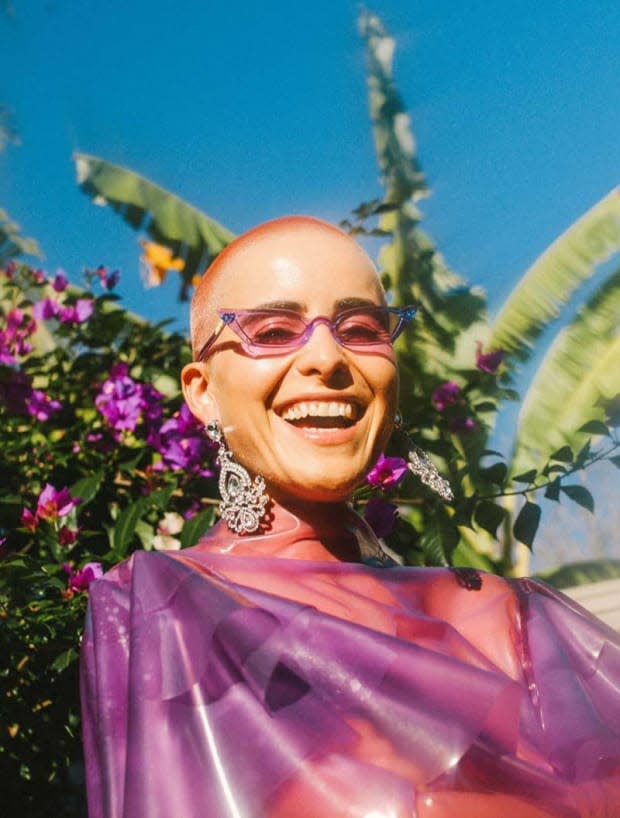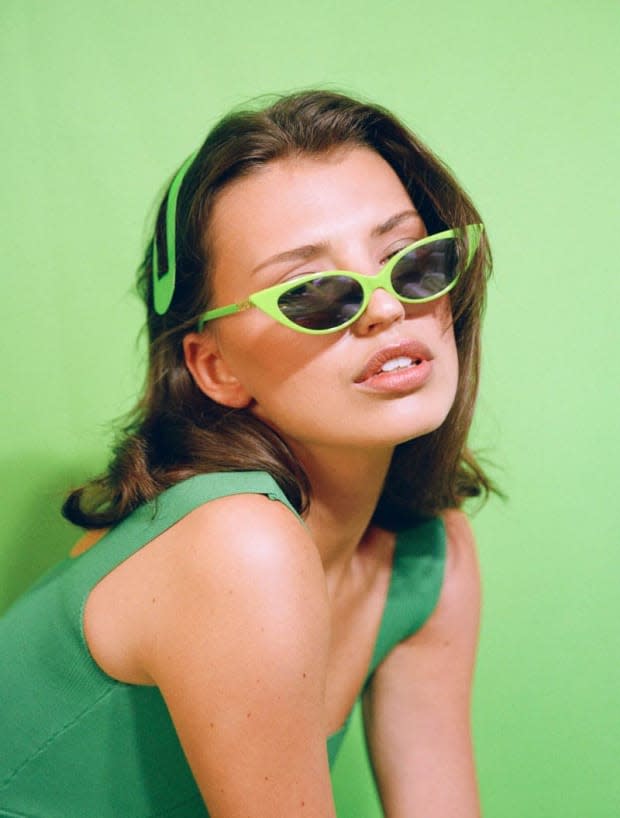How Poppy Lissiman Turned Her 'Terrible' First Eyewear Collection Into the Most Popular Sunglasses Brand on Instagram
We're not saying she singlehandedly brought "The Matrix" tiny shades trend mainstream, but we're not not saying it, either.

In our long-running series "How I'm Making It," we talk to people making a living in the fashion and beauty industries about how they broke in and found success.
We won't bore you by launching into an explainer about how Instagram is today's most successful (and preferred) platform for helping designers to get their businesses off the ground. Aside from being the number-one destination for buyers, stylists and consumers alike to discover new labels, it's an unbeatable marketing machine. Once a piece from an indie designer is worn by the right influencer, picked up by the right retailer, seeded to the right celebrity or shot by the right street style photographer and lands some prime real estate on our Instagram feeds, people immediately take notice — and start shopping.
One such status accessory that's dominated social media over the past couple of years is a pair of sunglasses by Australian designer Poppy Lissiman. Though she's been in business for more than a decade, her super-trendy, rainbow-colored ranges of accessibly priced glasses have become instantly recognizable both on- and offline — particularly the "Le Skinny," which was a key factor in the industry-wide revival of the early aughts "Matrix" aesthetic. Many of the biggest tastemakers in the world have worn Lissiman's highly photogenic designs, including Rihanna, Lady Gaga, Kourtney Kardashian, Emily Ratajkowski, Shay Mitchell, Hailey Bieber (née Baldwin) and both Hadid sisters. Even CGI influencer Lil Miquela has posted outfit photos including Lissiman's glasses to her grid, further proving that the designer has gained the digital fashion space's full attention.
Growing up in small-town Perth, Lissiman's mother — who worked in the fashion industry as a buyer — taught her how to sew when she was around ten years old. In these pre-internet days, she would buy European magazines to browse the seasonal runway collections in full, resulting in both awe and frustration, as the kind of clothing she loved reading about wasn't accessible where she lived. "I remember thinking, 'Oh my god, this is how I want to dress, the clothes I want to wear," she says. Before long, the tween Lissiman graduating from making quilts and clothing for her cat to designing full-on outfits for herself and her friends.
Fast-forward to now, and Lissiman's worked in nearly every facet of the industry (most of the time, working for herself). Through trial and error, strategic adaptations to her business strategy and staying ahead of the curve on all things digital, she's emerged as one of Instagram's favorite accessories designers. Over the phone from Australia, she talked us through her unconventional career path — from opening a brick-and-mortar store and designing a range of ready-to wear, to eventually going all in on eyewear and e-commerce. Read on for the highlights of our conversation.

Did you go to university or just hop right into working in fashion?
I did go to university — at the time I really wanted to be a doctor. I was trying to get into medical school and I failed the test you needed to get in. My next passion was literature, so I started an arts degree in literature and philosophy but quickly realized that there would not be very many job prospects at the end of that one. I only did that for about a year and then I moved into a more creative field doing a Bachelor of Arts in graphic design, fine art and art history. But, again, I only stuck with that for a short period of time.
At that point I was also working full-time at a shoe store. I really fell in love with retail and sales. All I wanted was to have my own shop. I had completely lost interest in university and decided that I wanted to learn absolutely everything I could from the back end of a successful retail business and the fashion business. Not many courses where I'm from in Australia do that. I figured dropping out of university and doing a more hands-on approach was the best way around it. That's what I did, and three years later I actually opened my first store.
What gave you the confidence to go out on your own so quickly?
I started making clothing, and did a couple of collections. I just saw starting a label as a stepping stone to eventually getting a shop. I was 18 or 19 when I started it; obviously I didn't have enough money to rent a retail store, do it up, buy stock, and all that sort of thing. So, I saved up my own money to start a label to make that a more economical way of doing it. I had about $15,000; with that I produced my first sample collection which did well and I made my money back. In the initial stages I was very, very, very, hands-on. It was all made locally, which meant that it was ridiculously expensive. I did it like that for about six years, and in 2011 I opened a retail store.
The intention was to have my own branding, plus other brands as well; I was mostly just trying to get brands which weren't available in Australia at the time. I had the store for almost three years. Toward the end, I was actually struggling to continue making a label of clothing, wholesale that label to other stores, have it in my own store and have other brands in the store, do the buying, run the store and have all the money to do all that. It was expensive and really hard, but an amazing learning experience.
How did you decide to branch out from designing ready-to-wear into accessories?
I actually took one season off my own brand to focus on the shop, because the shop was doing quite well. In that period I set up an online store, which was an extension of the actual store since we been around 2012. During that season off, we were really low on accessories. I was buying them from a few other brands, but [they didn't exactly have] what we wanted at the time.
I was in contact with my factory overseas and sent them a couple of designs for some clutch bags, which they made. These were the first bags I ever did. We put them online and in the store and we sold out of 100 in the first couple of weeks. At that point, we started working with Instagram, obviously, and started working with a few influencers and rode that initial wave — we sent 15 products to influencers and kind of got on board with that whole thing. I kind of fell into accessories by mistake, but it worked out really well.
I chose to close the shop after three years. I had my lease renewal and I chose not to renew it because online [e-comm] started making more money than the actual store. It just didn't make sense to have brick-and-mortar which cost a lot of money to keep open every month, with staff, rent, overhead, everything. Online, you can run it out of everywhere, anywhere, and it ... you know, I could do it, just myself. It was kind of a no brainer then.

Can you discuss your move from the traditional retail model to one that was newer and primarily online-focused?
The trajectory of my business completely changed as soon as I switched to accessories [and focused on e-commerce]. Suddenly, people in America were buying it. People all over the world. And, before that, my pool of customers was very small.
Around this time I met the founders of Triangl Swim, and they were one of the first that really pioneered that "Instagram" brand and the success of it. They did everything I was about to do, or was doing, on a much bigger scale. But they had done it really, really well. They had gone from having a similar brand that they were wholesaling to lots of other stores, and then they just shut down all those operations and just did direct to consumer via their online store, promoting only through Instagram, influencer marketing, just gifting product.
In 2012 there were people doing this, but it was nowhere near as prevalent as it was today. That was a pretty bold move, to go against everything you've learned in the industry and then just flip it. So, in terms of launching a collection, because I had ditched the whole wholesale model, I only was creating products that customers wanted based on the data of what was selling already. I only launched with two [clutches], one sold better than the other. I essentially kept ordering that one, did it in more styles, and that really worked — that was the evil eye clutch. And then, I kept reworking more styles with eyes on them, just developing things according to what the consumers' reaction was to it.
Because I wasn't wholesaling, I had to make a sample, and then make my own personal decision whether or not I was going to make 100 of it with a factory, without having shown it to any buyers. I wasn't getting any of that insider feedback. For the first year after switching to accessories I just clutch bags, and we sent a handful to Leandra Medine. Phil Oh snapped a really gorgeous photo of her wearing it. My followers went up, like hugely spiked. And then they did an interview with me for Man Repeller. We couldn't remake the clutches quick enough after that.
Now you're famous online for your sunglasses — what was your first eyewear collection like?
Eyewear with my first collection did absolutely terribly. I still, to this day, have a lot of them left over. I was really disheartened. Eyewear is expensive to make, and you have to make a lot of them. I started off with about five styles, and one did okay. But, the other five did not do well at all. I was self-taught, creating something which was essentially very 3D, and so different from clothing.
I considered not doing another one, but at the same time I had one style out of the five, with one color, that did quite well. It gave me a little bit of faith that I could maybe get it the next time round. Then I did another collection, but much smaller. Again, based off what I learned from the previous collection. What shapes sold best? What colors worked best? That sort of thing. And that did a little bit better.
One of your frames, the "Le Skinny," not only went viral, but helped usher in that whole "The Matrix" trend. How did those come about?
When it comes to designing frames, I try to think if I've seen [something like it] before. And, if I haven't, then I work on that idea as much as possible. That's where the "Le Skinny" came from. Sunglasses around that time were still quite big, but I could see that there was a trend — not just in accessories but also clothing — that we were coming back around to that early 2000s vibe.
I didn't see any sunglasses on the market that were that kind of shape, or that kind of vibe. I think around that time, I'd just re-watched "The Matrix" because it's such an iconically made Australian film that I don't think many people know was made in Sydney. I saw the really small sunglasses [and] I went, "That's actually really cool!" I think I really just came in at the right time with that trend; obviously [other designers] did it, but my price point was probably one of the cheapest. And then Bella Hadid and such were wearing them. I think if people think of my brand, that's probably always, for a while to come, what they're gonna think of: Those really tiny sunglasses and lots of really bright colors.

What advice do you have for aspiring designers or entrepreneurs in the fashion space, which is notoriously fickle?
I think the reason why I've been able to stay around over 10 years is just having a good sense of business. You know, understand money going in, money going out. Limitations you might have, and creative ways around that. Not overextending yourself if you can't afford to. Making smart business decisions, that sort of thing.
I was terrible at math in school. In fact, I didn't even take math beyond year 10. But, after leaving school and starting my business, as soon as you put a dollar sign in front of any math equation, suddenly you start to learn math a lot quicker than you do when you're at school. In the early days I'd have to do like, business activity statements, and all my accounting, and do all my invoices, and you know that makes up, I think, a much bigger portion of any business than the creative side.
I tell people that the creative side really only makes up about 2 percent of the business itself, or even day to day. For anyone who's looking to get into fashion, or looking to start their own brand, look at taking a small business course, or taking an accounting course, or just schooling yourself as much as you can on the business side of things, or surrounding yourself with people that can really help you in that area.
You see a lot of businesses come and go in this industry because, let's be honest, most creative people — and I'm definitely one of them — find that side of the world quite soul crushing. I hate doing invoices. I hate adding up numbers and looking at the fields and stuff. It's boring to me. But, you have to learn how to get good at it otherwise you might not be able to go forward, if you've already tried to go forward, you know?
This interview has been edited and condensed for clarity.
Sign up for our daily newsletter and get the latest industry news in your inbox every day.
